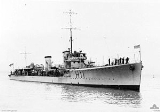
HMAS Swordsman
Encyclopedia
HMAS Swordsman (H11) was an Admiralty S class destroyer
S class destroyer (1916)
The S class were a class of 67 destroyers built from 1917 for the Royal Navy. The design was based on the Admiralty modified R class and all ships had names beginning with S or T....
of the Royal Australian Navy
Royal Australian Navy
The Royal Australian Navy is the naval branch of the Australian Defence Force. Following the Federation of Australia in 1901, the ships and resources of the separate colonial navies were integrated into a national force: the Commonwealth Naval Forces...
(RAN). Built for the Royal Navy
Royal Navy
The Royal Navy is the naval warfare service branch of the British Armed Forces. Founded in the 16th century, it is the oldest service branch and is known as the Senior Service...
during World War I, the ship was not completed until 1919, and was transferred to the RAN at the start of 1920. The destroyer's career was uneventful, with most of it spent moored in Sydney. Swordsman was decommissioned in 1929, and was sold for ship breaking
Ship breaking
Ship breaking or ship demolition is a type of ship disposal involving the breaking up of ships for scrap recycling. Most ships have a lifespan of a few decades before there is so much wear that refitting and repair becomes uneconomical. Ship breaking allows materials from the ship, especially...
in 1937.
Design and construction
Swordsman was built to the Admiralty design of the S class destroyerS class destroyer (1916)
The S class were a class of 67 destroyers built from 1917 for the Royal Navy. The design was based on the Admiralty modified R class and all ships had names beginning with S or T....
, which was designed and built as part of the British emergency war programme. The destroyer had a displacement of 1,075 tons, a length of 276 feet (84.1 m) overall and 265 feet (80.8 m) between perpendiculars, and a beam of 26 in 10 in (8.18 m). The propulsion machiney consisted of three Yarrow boilers feeding Brown-Curtis turbines, which supplied 27000 shp to the ship's two propeller shafts. Success a maximum speed of 33 knots (18 m/s), and a range of 2990 nautical miles (5,537.5 km) at 11.5 knots (6.3 m/s). The ship's company was made up of 6 officers and 93 sailors.
The destroyer's primary armament consisted of three QF 4-inch Mark IV guns
QF 4 inch naval gun Mk IV, XII, XXII
The QF 4-inch gun Mk IV was introduced in 1911 as a faster-loading light gun successor to the BL 4 inch Mk VIII gun, and was the main gun on most Royal Navy and British Empire destroyers in World War I.-Mk IV gun:...
. These were supplemented by a 2-pounder pom-pom, two 9.5-inch howitzer bomb throwers, five .303 inch machine guns
.303 British
.303 British, or 7.7x56mmR, is a .311 inch calibre rifle and machine gun cartridge first developed in Britain as a blackpowder round put into service in December 1888 for the Lee-Metford rifle, later adapted to use smokeless powders...
(a mix of Lewis
Lewis Gun
The Lewis Gun is a World War I–era light machine gun of American design that was perfected and widely used by the British Empire. It was first used in combat in World War I, and continued in service with a number of armed forces through to the end of the Korean War...
and Maxim gun
Maxim gun
The Maxim gun was the first self-powered machine gun, invented by the American-born British inventor Sir Hiram Maxim in 1884. It has been called "the weapon most associated with [British] imperial conquest".-Functionality:...
s), two twin 21-inch torpedo tube sets, two depth charge
Depth charge
A depth charge is an anti-submarine warfare weapon intended to destroy or cripple a target submarine by the shock of exploding near it. Most use explosives and a fuze set to go off at a preselected depth in the ocean. Depth charges can be dropped by either surface ships, patrol aircraft, or from...
throwers, and two depth charge chutes.
Swordsman was laid down by Scott's Shipbuilding and Engineering Company at their Greenock
Greenock
Greenock is a town and administrative centre in the Inverclyde council area in United Kingdom, and a former burgh within the historic county of Renfrewshire, located in the west central Lowlands of Scotland...
shipyard in 1917. The destroyer was launched on 28 December 1918, and completed during March 1919. After completion, the destroyer was marked for transfer to the RAN, along with four sister ship
Sister ship
A sister ship is a ship of the same class as, or of virtually identical design to, another ship. Such vessels share a near-identical hull and superstructure layout, similar displacement, and roughly comparable features and equipment...
s. Swordsman was commissioned into the RAN on 27 January 1920.
Operational history
After arriving in Australian waters, the majority of Swordsmans career was spent moored in Sydney.Decommissioning and fate
Swordsman was paid off into reserve on 21 December 1929. She was sold to Penguins Limited for ship breakingShip breaking
Ship breaking or ship demolition is a type of ship disposal involving the breaking up of ships for scrap recycling. Most ships have a lifespan of a few decades before there is so much wear that refitting and repair becomes uneconomical. Ship breaking allows materials from the ship, especially...
on 4 June 1937.

